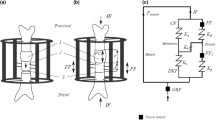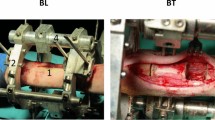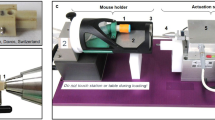Abstract.
Micromovement at fracture sites is known to promote callus formation and bridging of the bony fragments. The present study was conducted to identify the suitable amount of micromovement, and to analyze the location and timing of callus proliferation. A standardized transverse osteotomy, in the right metatarsus of 32 sheep, was used as a fracture model. The osteotomy was externally fixed with a special ring fixator, which allowed axial micromovements of defined sizes. The animals were divided into four groups, with gaps of 2 mm and 6 mm, and micromovements of 0.3 mm and 0.7 mm, respectively. The labeling of new bone formation was performed by the intravenous injection of calcein green in the fourth week and tetracycline in the eighth week. Nine weeks postoperatively the sheep were killed. The explanted metatarsals were radiographed for the measurement of the periosteal callus area and were nondestructively loaded in a three-point bending test to determine their flexural rigidity. Histological analysis of undecalcified bone was performed in bone slices in the sagittal plane. Fluorescent green (callus formed in the fourth week) and yellow areas (callus formed in the eighth week) and the area of connective tissue were determined, using fluorescence microscopy. Bone formation was larger in the eighth week than that in the fourth week in all groups. In the fourth week, large micromovements in the small gap resulted in increased bone formation, whereas, for large gaps, the large micromovements diminished new bone formation. With large micromovement, the amount of newly formed bone within the gap decreased with increasing gap size, suggesting a delay of bone healing. Stimulation of new bone formation by micromovement was mainly effective in the early healing phase (4 weeks postoperatively). Large gaps showed the least new bone formation at the fracture site and the lowest flexural rigidity. From the histological analysis, it was found that the flexural rigidity correlated with the new bone area in the periosteal region.
Similar content being viewed by others
Author information
Authors and Affiliations
Additional information
Received: February 21, 2001 / Accepted: July 11, 2001
About this article
Cite this article
Yamaji, T., Ando, K., Wolf, S. et al. The effect of micromovement on callus formation. J Orthop Sci 6, 571–575 (2001). https://doi.org/10.1007/s007760100014
Issue Date:
DOI: https://doi.org/10.1007/s007760100014




